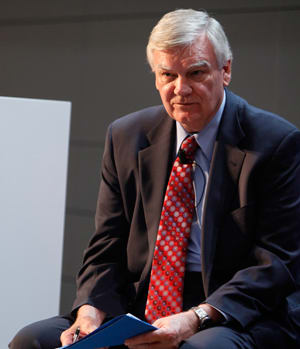
President Bill Clinton came to power acutely aware that the American public had denied George H.W. Bush a second term, in no small part because they felt he was excessively focused on international affairs at the expense of domestic priorities.
Accordingly, investing in the budget of the U.S. Agency for International Development was never the president’s highest priority as he significantly revived domestic economic growth. That said, President Clinton did make investment in Central and Eastern Europe a high priority, and although assistance programs in the region were often bumpy, they did help a good number of nations successfully manage the transition to open markets and democracy — an effort considerably aided by the general attractiveness of European integration.
Arguably no other administrator faced a more hostile operating environment than Brian Atwood (1993-1999), who was at the helm for the bulk of Clinton’s two terms. Atwood is also the agency’s the second-longest-serving administrator.
Atwood had good international pedigree. He was a former foreign service officer, dean of the Foreign Service Institute, assistant secretary for congressional affairs and president of the National Democratic Institute. Atwood inherited a scandal-plagued and badly demoralized agency, acknowledging early in his term, “we are in deep trouble.” With the Cold War over, both President Clinton and Congress looked to USAID’s budget for savings and a domestic “peace dividend.”
Upon taking office, Atwood invested heavily in improving Congressional relations and made a concerted push to rewrite the badly outdated Foreign Assistance Act of 1961. USAID was designated as one of the three “reinvention laboratories” within the federal government as part of Vice President Al Gore’s “Reinventing Government” initiative, and pursued a series of bureaucratic reforms. Most notably, USAID closed more than 26 missions in countries that had either graduated from the need for aid or were simply bad partners — the first reduction in the number of countries receiving U.S. assistance since the Marshall Plan.

Atwood promoted a vision of sustainable development with an emphasis on democratic reforms. But his window of opportunity was short. After Republicans swept both the House and the Senate in the midterm 1994 elections, he faced a multifront war as both Senator Jesse Helms and the U.S. State Department tried to abolish the agency and fold it into the State Department.
As Congress slashed USAID’s operating budget, Atwood was forced to lay off substantial numbers of staff and deeply cut some core agency functions such as agriculture and evaluation. Assistant Administrator for Management Larry Byrne was easily Atwood’s most contentious appointment. Byrne botched a massive agencywide computer upgrade at considerable cost while alienating key senior staff in the process. One USAID staffer called Atwood’s reluctance to sack Byrne “a fatal flaw,” and the mere mention of Byrne’s name is enough to provoke a vehement response from most veteran USAID staffers to this day.
But it is not overstatement to say that USAID would simply no longer exist if it was not for Atwood’s intestinal fortitude in standing up to both the secretary of state and the chairman of the Senate foreign relations committee. Still bitter about losing the battle to abolish USAID, Senator Helms blocked Atwood’s nomination as ambassador to Brazil upon his departure from USAID.
J. Brady Anderson (1999-2001) served out the tail end of the Clinton administration. A friend of the Clinton family, Anderson earned generally positive marks for his five-year service as U.S. ambassador to Tanzania; he had learned Swahili during his earlier work in the region with Wycliffe Bible translators.
Anderson’s tenure brought a respite from the bruising battles of the Atwood years. He saw some marginal improvements in the budget and operating expenses, while emphasizing the importance of women in development. Absent major scandals or major breakthroughs, one USAID observer described Anderson as being in “cruise control” for most of his term.
More on the history of US foreign aid
▪ The evolution of the USAID administrator
▪ Part 1: Kennedy, Johnson and the early years
▪ Part 2: The Cold War and its aftermath
▪ Part 4: Sept. 11 and beyond
▪ Part 5: Lessons for the future
Anderson was fond of telling staff that he viewed himself as a caretaker, and it is difficult to disagree with his own assessment. USAID had survived a sustained Congressional assault on its existence during the 1990s, but barely. The agency was hollowed-out, with its staff cut by 29 percent between 1995 and 2000, and a direct-hire staff about half the size it had been 20 years earlier. At least one-third of USAID remaining staff were nearing retirement age.
More and more, USAID had no choice but to let contractors do the work that had traditionally been done in-house. The agency was incredibly poorly positioned for the momentous changes just around the corner.
A series of coordinated attacks on U.S. soil significantly influenced American foreign policy from Sept. 11 and beyond, the fourth installation of our five-part series.
Click here to view our complete interactive series exploring the history of USAID, its administrators and US foreign aid. Join the conversation with our community on social media using #USAIDhistory and don't forget share this series with fellow development professionals, researchers and academics.








